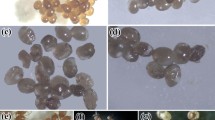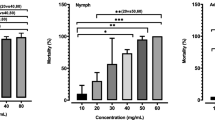Abstract
The aim of the study was to evaluate the in vitro efficacy of different concentrations of ethanolic extract obtained from the aerial parts of Artemisia absinthium in comparison to amitraz on adults, eggs and larvae of Hyalomma anatolicum using the adult immersion test (AIT), egg hatchability test and larval packet test (LPT), respectively. Four concentrations of the extract (2.5, 5, 10 and 20 %) with three replications for each concentration were used in all the bioassays. In AIT, the mortality rates at 2.5, 5 and 10 % were significantly different (p < 0.05) in comparison to the control group; however, at 20 %, it was similar to the positive control group. Maximum mortality of 86.7 % was recorded at 20 %. The LC50 and LC95 values were calculated as 6.51 and 55.43 %, respectively. The oviposition was reduced significantly by 36.8 and 59.1 % at concentrations of 10 and 20 %, respectively. Egg hatchability was reduced significantly at all concentrations (2.5–20 %) in comparison to the control. In LPT, the extract caused 100 % mortality of larvae at all the concentrations after 24 h. The results show that ethanolic extract obtained from the aerial parts of A. absinthium has acaricidal properties and could be useful in controlling H. anatolicum.

Similar content being viewed by others
References
Abdel-Shafy S, Zayed AA (2002) In vitro acaricidal effect of plant extract of neem seed oil (Azadirachta indica) on egg, immature, and adult stages of Hyalomma anatolicum excavatum (Ixodoidea: Ixodidae). Vet Parasitol 106:89–96
Abdel-Shafy S, El-Khateeb RM, Soliman MMM, Abdel-Aziz MM (2009) The efficacy of some wild medicinal plant extracts on the survival and development of third instar larvae of Chrysomyia albiceps (Wied) (Diptera: Calliphoridae). Trop Anim Health Prod 41:1741–1753
Bagavan A, Kamaraj C, Elags G, Zahir A, Rahuman A, Abdul A (2009) Adulticidal and larvicidal efficacy of some medicinal plants extracts against ticks, flukes and mosquitoes. Vet Parasitol 166:286–292
Baytop T (1984) Therapy with medicinal plants in Turkey. Istanbul University Press, Istanbul, pp 166–167
Cetin H, Cilek JE, Oz E, Aydin L, Deveci O, Yanikoglu A (2010) Acaricidal effects of Satureja thymbra L. essential oil and its major components, carvacrol and γ–terpinene against adult Hyalomma marginatum (Acari: Ixodidae). Vet Parasitol 170:287–290
Chagas ACS, Georgetti CS, de Carvalho CO, Oliveira MCS, Rodrigues RA, Foglio MA, de Magalhaes PM (2011) In vitro activity of Artemisia annua L (Asteraceae) extracts against Rhipicephalus (Boophilus) microplus. Rev Bras Parasitol Vet Jaboticabal 20:31–35
Chopra RN, Nayer SL, Chopra IC (1992) Glossary of Indian medicinal plants, 3rd edn. New Delhi, Council of Scientific and Industrial Research, p 246
Drummond RO, Ernst SE, Trevino JL, Gladney WJ, Graham OH (1973) Boophilus annulatus and Boophilus microplus: laboratory test of insecticides. J Econ Entomol 66:130–133
Ekanem AP, Brisibe EA (2010) Effects of ethanol extracts of Artemisia annua L. against monogeneans parasites of Heterobranchus longifilis. Parasitol Res 106:1135–1139
FAO (2004) Resistance management and integrated parasite control in ruminants- Guidelines, Module I- Ticks: Acaricide resistance: Diagnosis, management and prevention. Food and Agriculture Organisation, Animal Production and Health Division, Rome, pp 25–77
Ferreira JFS, Gonzalez JM (2008) Chemical and biological stability of artemisinin in bovine rumen fluid and its kinetics in goats (Capra hircus). Rev Bras Parasitol Vet 17(Suppl):103–109
Finney DJ (1962) Probit analysis—a statistical treatment of the response curve. Cambridge University Press, Cambridge
Ghosh S, Bansal GC, Gupta SC, Ray DD, Khan MQ, Irshad H, Shahiduzzaman M, Seitzer U, Ahmed JA (2007) Status of tick distribution in Bangladesh, India and Pakistan. Parasitol Res 101(Suppl 2):S207–S216
Godara R, Parveen S, Katoch R, Yadav A, Verma PK, Katoch M, Kaur D, Ganai A, Raghuvanshi P, Singh NK (2014) Acaricidal activity of extract of Artemisia absinthium against Rhipicephalus sanguineus of dogs. Parasitol Res 113:747–754
Han X, Shen T, Lou H (2007) Dietary polyphenols and their biological significance. Int J Mol Sci 8:950–988
Juteau F, Jerkovic I, Masotti V, Milos M, Mastelic J, Bessiere JM, Viano J (2003) Composition and antimicrobial activity of essential oil of Artemisia absinthium from Croatia and France. Planta Med 69:158–161
Keiser J (2008) Efficacy and safety of artemether against a natural Fasciola hepatica infection in sheep. Parasitol Res 103:517–522
Khater HF, Ramadan MY, El-Madawy RS (2009) Lousicidal, ovicidal and repellent efficacy of some essential oils against lice and flies infesting water buffaloes in Egypt. Vet Parasitol 164:257–266
Koul MK (1997) Medicinal plants of Kashmir and Ladakh, Temperate and Cold arid Himalaya. Indus Publishing Company, FS-5, Tagore Garden, New Delhi, p 102
Krishna Kumar PR (1996) Indian medicine industry under the emerging patent regimes. Ancient Sci Life 15:161
Minjauw B, McLeod A (2003) Tick-borne diseases and poverty. The impact of ticks and tick-borne diseases on the livelihood of small scale and marginal livestock owners in India and eastern and southern Africa. Research report, DFID Animal Health Programme, Centre for Tropical Veterinary Medicine, University of Edinburgh, UK, pp 59–60
Mohamed AH, El-Sayed MA, Hegazy ME, Helaly SE, Esmail AM, Mohamed NS (2010) Chemical constituents and biological activities of Artemisia herba-alba. Rec Nat Prod 4:1–25
Pillay P, Maharaj VJ, Smith PJ (2008) Investigating South African plants as a source of new antimalarial drugs. J Ethnopharmacol 119:438–454
Shyma KP, Kumar S, Sharma AK, Ray DD, Ghosh S (2012) Acaricide resistance status in Indian isolates of Hyalomma anatolicum. Exp Appl Acarol 58:471–481
Singh NK, Jyoti, Rath SS (2013) Detection of acaricidal resistance in Hyalomma anatolicum anatolicum. Indian Vet J 90:17–19
Singh NK, Jyoti, Haque M, Singh H, Rath SS, Ghosh S (2014a) A comparative study on cypermethrin resistance in Rhipicephalus (Boophilus) microplus and Hyalomma anatolicum from Punjab (India). Ticks Tick Borne Dis 5:90–94
Singh NK, Jyoti, Vemu B, Nandi A, Singh H, Kumar R, Dumka VK (2014b) Laboratory assessment of acaricidal activity of Cymbopogon winterianus, Vitex negundo and Withania somnifera against deltamethrin resistant Hyalomma anatolicum. Exp Appl Acarol. doi:10.1007/s10493-014-9791-1
Singh R, Verma PK, Singh G (2012) Total phenolic, flavonoids and tannin contents in different extracts of Artemisia absinthium. J Intercult Ethnopharmacol 1:101–104
Soulsby EJL (1982) Helminths, arthropods and protozoa of domesticated animals, 7th edn. Bailliere Tindal, London, p 462
Van Wyk BE, Wink M (2004) Medicinal plants of the world: An illustrated guide to important medicinal plants and their uses. Times ed, pp 54
Author information
Authors and Affiliations
Corresponding author
Rights and permissions
About this article
Cite this article
Godara, R., Parveen, S., Katoch, R. et al. Acaricidal activity of ethanolic extract of Artemisia absinthium against Hyalomma anatolicum ticks. Exp Appl Acarol 65, 141–148 (2015). https://doi.org/10.1007/s10493-014-9843-6
Received:
Accepted:
Published:
Issue Date:
DOI: https://doi.org/10.1007/s10493-014-9843-6




